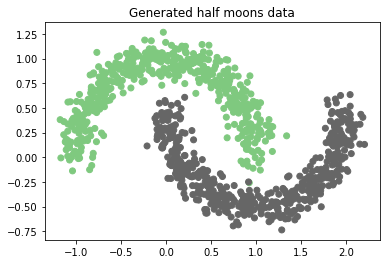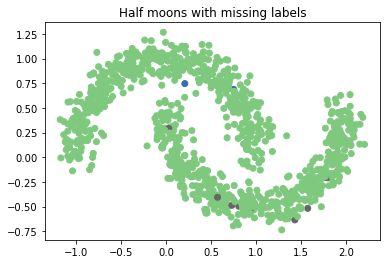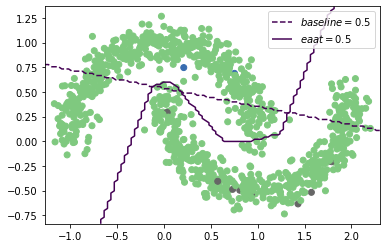Half Moons Example¶
This notebook demonstrates the use of Shadow for the canonical semi-supervised learning example: half moons.
A strictly supervised (only labeled data) baseline model is trained alongside the same model architecture trained using Exponential Averaging Adversarial Training (EAAT).
[1]:
import shadow.utils
shadow.utils.set_seed(0, cudnn_deterministic=True) # set seeds for reproducibility
Create Data¶
Half moons data is generated using the scikit-learn toy datasets interface.
[2]:
%matplotlib inline
import matplotlib.pyplot as plt
from sklearn import datasets
n_samples = 1000 # number of samples to generate
noise = 0.1 # noise to add to sample locations
x, y = datasets.make_moons(n_samples=n_samples, noise=noise)
plt.scatter(*x.T, c=y, cmap=plt.cm.Accent)
plt.title("Generated half moons data");

Drop Labels¶
Since the half moons dataset is synthetic, all labels are available. To test out the semi-supervised learning infrastructure, we artificially remove 99% of labels. To demarcate “unlabeled” samples, we set their corresponding label to -1. This is convenient method to handle missing classification labels in torch, as we will see later in the definition of the cross entropy loss.
[3]:
import copy
import numpy as np
unlabeled_frac = 0.99 # fraction of data to drop labels
y_ssml = y.copy()
unlabeled = np.random.choice(range(n_samples), size=int(unlabeled_frac * n_samples), replace=False)
y_ssml[unlabeled] = -1 # set missing labels to -1
plt.scatter(*x.T, c=y_ssml, cmap=plt.cm.Accent)
plt.title("Half moons with missing labels");

Train a classifier¶
Next, we will instantiate the various training objects used in torch: models, optimizers, and criterion.
Model Architecture¶
We define our simple model architecture for use on this toy problem. We wrap this model into a factory, so that we can produce it twice: once for the baseline and once for the semi-supervised test.
[4]:
import torch
def model_factory():
return torch.nn.Sequential(
torch.nn.Linear(2, 10),
torch.nn.ReLU(),
torch.nn.Linear(10, 10),
torch.nn.ReLU(),
torch.nn.Linear(10, 2)
)
device = torch.device('cpu') # run on cpu, since model and data are very small
Baseline Model¶
The baseline model and optimizer are defined normally.
[5]:
bl = model_factory().to(device)
bl_opt = torch.optim.SGD(bl.parameters(), lr=0.1, momentum=0.9)
Semi-supervised Model¶
The semi-supervised model is instantiated with one critical difference: the model is wrapped by the shadow-provided ssml technique (in this case Exponential Averaging Adversarial Training). The wrapper defines additional technique-specific hyperparameters, but should be instead of using a plain model directly.
[6]:
import shadow.eaat
eaat = shadow.eaat.EAAT(model=model_factory(), alpha=0.8, xi=1e-4, eps=0.3).to(device)
eaat_opt = torch.optim.SGD(eaat.parameters(), lr=0.1, momentum=0.9)
Loss function¶
As was alluded to earlier, using -1 to indicate missing labels is convenient in torch. That is because our standard CrossEntropyLoss criterion already has a parameter to ignore specific label values. We simple instatiate the loss function as normal, but set that parameter (ignore_index) to our unlabeled value.
Other loss functions may provide such a functionality or may need to be manually modified so as to mask data with missing labels.
[7]:
xEnt = torch.nn.CrossEntropyLoss(ignore_index=-1).to(device)
Training Loop¶
We train both the baseline and semi-supervised models at the same time using standard torch conventions. Since the half-moons dataset is a small toy example, we use the whole dataset at once instead of batching.
The only modification to the training loop needed for the semi-supervised model is that the loss function is composed of both the supervised loss (xEnt) as well as a technique provided unsupervised loss (eaat.get_technique_cost). The details of this unsupervised loss vary between techniques, but it provides the mechanism for semi-supervised learning.
[8]:
n_epochs = 500
xt, yt = torch.Tensor(x).to(device), torch.LongTensor(y_ssml).to(device)
for epoch in range(n_epochs):
# Standard forward/backward pass for training baseline
out = bl(xt)
loss = xEnt(out, yt) # ignores the unlabeled data (-1)
bl_opt.zero_grad()
loss.backward()
bl_opt.step()
# Forward/backward pass for training semi-supervised model
out = eaat(xt)
loss = xEnt(out, yt) + eaat.get_technique_cost(xt) # supervised + unsupervised loss
eaat_opt.zero_grad()
loss.backward()
eaat_opt.step()
Evaluate performance¶
Finally, we evaluate and compare performance between our strictly supervised baseline model, and the same model trained using semi-supervised learning.
It is critical to set the EAAT wrapped model into eval mode after training, so as to disable certain augmentations performed for semi-supervised learning.
[9]:
bl.eval()
eaat.eval();
The accuracy provided by SSML greatly outperforms that of the baseline, as we would expect.
[10]:
import shadow.losses
bl_pred = torch.max(bl(xt), 1)[-1]
eaat_pred = torch.max(eaat(xt), 1)[-1]
print("bl accuracy:", shadow.losses.accuracy(bl_pred, torch.LongTensor(y)).data)
print("eaat accuracy", shadow.losses.accuracy(eaat_pred, torch.LongTensor(y)).data)
bl accuracy: tensor(75.9000, dtype=torch.float64)
eaat accuracy tensor(98.7000, dtype=torch.float64)
Visualize Decision Boundary¶
In order to get a better sense of how “good” our EAAT trained model is, we can leverage the fact that half-moons is a toy 2D dataset to visualize the model decision boundary. We define a 2D meshgrid over the data space and evaluate the models over the grid. We then plot the contour corresponding to a score of 0.5, which represents the decision boundary.
As illustrated in the plot, the baseline learns exactly what it can from the labeled data. However the semi-supervised trained model learns both labeled and unlabeled data and captures the overall data trends despite having labels for only 1% of the training data.
[11]:
# Determine grid range
x0_min, x0_max = x[:, 0].min() - 0.1, x[:, 0].max() + 0.1
x1_min, x1_max = x[:, 1].min() - 0.1, x[:, 1].max() + 0.1
# Create grid
x0, x1 = np.meshgrid(np.linspace(x0_min, x0_max, 100),
np.linspace(x1_min, x1_max, 100))
grid = torch.FloatTensor(np.hstack((x0.reshape(-1, 1), x1.reshape(-1, 1))))
# Plot the data
plt.scatter(*x.T, c=y_ssml, cmap=plt.cm.Accent)
# Evaluate baseline on the grid and plot decision boundary
bl_pred = torch.max(bl(grid), 1)[-1].numpy().reshape(x0.shape)
cs = plt.contour(x0, x1, bl_pred, levels=[0.5], linestyles='--')
h1, l1 = cs.legend_elements("baseline")
# Evaluate EAAT on the grid and plot decision boundary
eaat_pred = torch.max(eaat(grid), 1)[-1].numpy().reshape(x0.shape)
cs = plt.contour(x0, x1, eaat_pred, levels=[0.5])
h2, l2 = cs.legend_elements("eaat")
plt.legend(h1 + h2, l1 + l2)
[11]:
<matplotlib.legend.Legend at 0x7f09007b5e20>

[ ]: